Finally done. 1,000 gal LP tank in, plumbed, and ran a test up to 160F yesterday. Fully closed system now. This will be "cool." Top of tank temp was 160; bottom of tank was 130. Although don't need much heat anymore, I will be running a test to bring entire tank up to 170+/- top and bottom. Pix follows. Just a few notes that may be of interest.
Storage tank is 1000 gal LP tank, 19' feet long; partially wrapped with 6" fiberglass. Unwrapped parts are for radiant heating in my shop (too much heat if totally unwrapped). Tank has drain valve on bottom and isolation valves. Storage side expansion tank is Amtrol SX-160.
Plumbing between plate HX ( 5" x 12" x 30 plate, 1" fittings) and storage tank: draw cold water from bottom of tank, through filter, to circ, through HX, hot water through unit heater, to top of tank. Unit heater is controlled by a separate thermostat and only used when immediate or supplemental heat needed (use very little).
Flexible plumbing (red in photos) is 200F rated high temp hose. Will see how this holds up over time, but so easy to install due to flexibility and simply use hose barbs.
Filter may be removed later as soon as I know it's not catching any debris that could clog the HX. Replaceable 50 micron element, isolation valves.
Top of storage tank plumbing, right to left: 1) hot water in on right, with air vent, pressure gauge, and tank water supply valve for filling, topping off, etc. 2) ball valve to be opened to add boiler chemical to tank as needed, can use only when tank is de-pressurized. 3) 30 psi pressure relief valve. 4) well fitting for temperature gauge in background. Two flat fittings in center are LP tank fill gauge and LP tank pressure relief valve (200+ psi).
Circ pump control: aquastat on boiler return line set at 150; controls both boiler and tank circ pumps. Allows boiler to get to operating temp quickly before starting water flow. Turns off at 140. Also have boiler on a timer that shuts system down in event "cold" tank water supply is above 140, so that pumps do not run continuously when not needed.
Boiler: Termovar valve to insure hot water return to boiler at all times; Automag controlled overheat loop on ceiling of shop. The Automag is controlled by a separate aquastat on boiler supply line set at 210. If supply water reaches 210, shuts off power to Automag, thus opening overheat loop. Boiler also has a 210 overheat shutoff, so draft fan shuts down at same temperature. Has never happened. Also, if power failure, boiler shuts down and Automag opens overheat loop.
Ash box (at bottom of boiler): 9" x 10" x 12" -- ash box fills about two weeks to month, depending on use of boiler to meet heat needs. I burn dry pine almost exclusively.
Zones: none of the traditional kind. Installation is in my shop, and tank heats the shop acting as a large radiator; only use unit heater if immediate or supplemental heat needed.
Issues: needed boiler chemical to get PH to 8-9 range. Water supply is a little on the acid side, and until PH got up to 7+ I was getting rusty water. Water now runs clear from storage tank. Boiler chemical raises PH and scavenges oxygen.
Storage tank is 1000 gal LP tank, 19' feet long; partially wrapped with 6" fiberglass. Unwrapped parts are for radiant heating in my shop (too much heat if totally unwrapped). Tank has drain valve on bottom and isolation valves. Storage side expansion tank is Amtrol SX-160.
Plumbing between plate HX ( 5" x 12" x 30 plate, 1" fittings) and storage tank: draw cold water from bottom of tank, through filter, to circ, through HX, hot water through unit heater, to top of tank. Unit heater is controlled by a separate thermostat and only used when immediate or supplemental heat needed (use very little).
Flexible plumbing (red in photos) is 200F rated high temp hose. Will see how this holds up over time, but so easy to install due to flexibility and simply use hose barbs.
Filter may be removed later as soon as I know it's not catching any debris that could clog the HX. Replaceable 50 micron element, isolation valves.
Top of storage tank plumbing, right to left: 1) hot water in on right, with air vent, pressure gauge, and tank water supply valve for filling, topping off, etc. 2) ball valve to be opened to add boiler chemical to tank as needed, can use only when tank is de-pressurized. 3) 30 psi pressure relief valve. 4) well fitting for temperature gauge in background. Two flat fittings in center are LP tank fill gauge and LP tank pressure relief valve (200+ psi).
Circ pump control: aquastat on boiler return line set at 150; controls both boiler and tank circ pumps. Allows boiler to get to operating temp quickly before starting water flow. Turns off at 140. Also have boiler on a timer that shuts system down in event "cold" tank water supply is above 140, so that pumps do not run continuously when not needed.
Boiler: Termovar valve to insure hot water return to boiler at all times; Automag controlled overheat loop on ceiling of shop. The Automag is controlled by a separate aquastat on boiler supply line set at 210. If supply water reaches 210, shuts off power to Automag, thus opening overheat loop. Boiler also has a 210 overheat shutoff, so draft fan shuts down at same temperature. Has never happened. Also, if power failure, boiler shuts down and Automag opens overheat loop.
Ash box (at bottom of boiler): 9" x 10" x 12" -- ash box fills about two weeks to month, depending on use of boiler to meet heat needs. I burn dry pine almost exclusively.
Zones: none of the traditional kind. Installation is in my shop, and tank heats the shop acting as a large radiator; only use unit heater if immediate or supplemental heat needed.
Issues: needed boiler chemical to get PH to 8-9 range. Water supply is a little on the acid side, and until PH got up to 7+ I was getting rusty water. Water now runs clear from storage tank. Boiler chemical raises PH and scavenges oxygen.


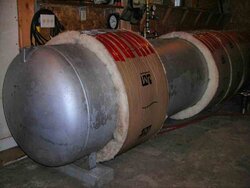
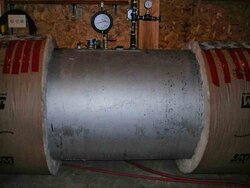
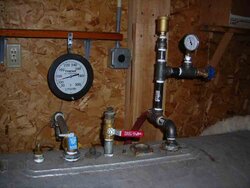
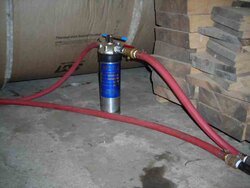
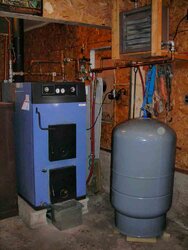
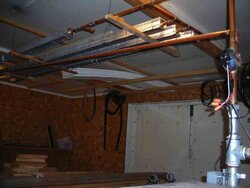
 I am concerned about running my hot water out of these tanks as I am using an old propane tank too. Expecially with kids and showers and dishes.
I am concerned about running my hot water out of these tanks as I am using an old propane tank too. Expecially with kids and showers and dishes.